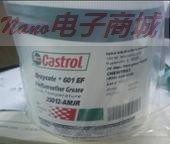
4. First aid measures
Eye contact In case of contact, immediately flush eyes with plenty of water for at least 15 minutes. Get medical
attention if symptoms occur.
Skin contact Flush contaminated skin with plenty of water. Remove contaminated clothing and shoes. Wash
clothing before reuse. Clean shoes thoroughly before reuse. Get medical attention if symptoms
occur.
Inhalation If inhaled, remove to fresh air. Get medical attention if symptoms occur.
Ingestion Do not induce vomiting unless directed to do so by medical personnel. Never give anything by
mouth to an unconscious person. If potentially dangerous quantities of this material have been
swallowed, call a physician immediately. Get medical attention if symptoms occur.
Notes to physician Note: High Pressure Applications
Injections through the skin resulting from contact with the product at high pressure constitute a
major medical emergency. Injuries may not appear serious at first but within a few hours tissue
becomes swollen, discolored and extremely painful with extensive subcutaneous necrosis.
Surgical exploration should be undertaken without delay. Thorough and extensive debridement of
the wound and underlying tissue is necessary to minimize tissue loss and prevent or limit
permanent damage. Note that high pressure may force the product considerable distances along
tissue planes.
5. Fire-fighting measures
Special remarks on fire
hazards
Hazardous decomposition products: Hydrogen fluoride (HF). and carbonyl difluoride.
Promptly isolate the scene by removing all persons from the vicinity of the incident if there is a fire.
No action shall be taken involving any personal risk or without suitable training.
Protective clothing (fire) Fire-fighters should wear appropriate protective equipment and self-contained breathing apparatus
(SCBA) with a full face-piece operated in positive pressure mode.
Fire-fighting procedures
Hazardous combustion
products
Combustion products may include the following:
halogenated compounds
carbon oxides (CO, CO2) (carbon monoxide, carbon dioxide)
nitrogen oxides (NO, NO2 etc.)
Fire/explosion hazards In a fire or if heated, a pressure increase will occur and the container may burst.
Flash point Not available.
Extinguishing media
Suitable Use an extinguishing agent suitable for the surrounding fire.
Not suitable Do not use water jet.
6. Accidental release measures
No action shall be taken involving any personal risk or without suitable training. Keep unnecessary
and unprotected personnel from entering. Do not touch or walk through spilled material. In
accordance with good industrial hygiene and safety work practices, airborne exposures should be
controlled to the lowest extent practicable. Provide adequate ventilation. Wear appropriate
respirator when ventilation is inadequate. Put on appropriate personal protective equipment (see
Section 8).
Stop leak if without risk. Move containers from spill area. Approach release from upwind. Prevent
entry into sewers, water courses, basements or confined areas. Wash spillages into an effluent
treatment plant or proceed as follows. Contain and collect spillage with non-combustible,
absorbent material e.g. sand, earth, vermiculite or diatomaceous earth and place in container for
disposal according to local regulations (see section 13). Dispose of via a licensed waste disposal
contractor. Contaminated absorbent material may pose the same hazard as the spilled product.